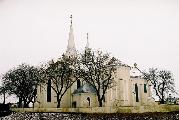Beltiug - The Roman Catholic Church of „King St. Ladislaus”
Document tools
 The settlement was acquired by the Dragoş family, at the end of the 14th century. The family was of Romanian origin from the county of Maramureş, but, starting with the acquisition of Beltiug, the descendants of the family called themselves, as “Dragoş of Beltiug”. A document from 1424 mentions that the church of Beltiug was dedicated to The Holy Virgin. The church was used by the Calvinists, starting from the middle of the 16th century. At the same time, all the communities from the domain of the Dragoş family embraced the reform and the churches were transferred to them. The church of Beltiug was given back to the Catholics, by the end of the century, in 1597, and it was dedicated to St. Ladislaus. The church was used again by the Calvinists during the 17th century (1634), until, in the 1720s, the new owner, count Alexander Károlyi moved the Calvinist community to the village Dobra, and colonized here Schwabs of Catholic origin. The right to use the church was given to the new inhabitants, who renovated and vaulted the building in 1730. The medieval church was built in late gothic style, with a polygonal sanctuary and a wide nave.
The settlement was acquired by the Dragoş family, at the end of the 14th century. The family was of Romanian origin from the county of Maramureş, but, starting with the acquisition of Beltiug, the descendants of the family called themselves, as “Dragoş of Beltiug”. A document from 1424 mentions that the church of Beltiug was dedicated to The Holy Virgin. The church was used by the Calvinists, starting from the middle of the 16th century. At the same time, all the communities from the domain of the Dragoş family embraced the reform and the churches were transferred to them. The church of Beltiug was given back to the Catholics, by the end of the century, in 1597, and it was dedicated to St. Ladislaus. The church was used again by the Calvinists during the 17th century (1634), until, in the 1720s, the new owner, count Alexander Károlyi moved the Calvinist community to the village Dobra, and colonized here Schwabs of Catholic origin. The right to use the church was given to the new inhabitants, who renovated and vaulted the building in 1730. The medieval church was built in late gothic style, with a polygonal sanctuary and a wide nave. The tower on the façade is octagonal on the upper levels, and it has an entrance with gothic frame and a freeze in pointed arch. The gothic frames of the windows and their tracery were still kept in the 19th century. The church was surrounded with a small, probably medieval, fence containing the representations of the Stations of the Passion. The church was transformed in neo-gothic style, according to the project of Foerk Ernő at the beginning of the 20th century: a new nave was built on the western side, and a new sanctuary on the southern side. The original sanctuary became a side chapel. The neo-gothic sanctuary contains the image of St. Ladislaus, alongside of four statues representing St. Stephen, St. Emeric, St. Adalbert and St. Gerard. Three engraved slabs of the thumb of Bálint Prépostváry (+1597) are incorporated in the main altar. The local tradition explains the origin of the village’s name with a legend: King St. Ladislaus was passing through the settlement and became thirsty, a soldier offered him wine in a pumpkin (=tök in Hung., the Hungarian name of the village kept the altered form of the ‘tök’ > ‘tek’ > Béltek); the king found the wine very tasty so donated the village to the soldier. (TSz).
The tower on the façade is octagonal on the upper levels, and it has an entrance with gothic frame and a freeze in pointed arch. The gothic frames of the windows and their tracery were still kept in the 19th century. The church was surrounded with a small, probably medieval, fence containing the representations of the Stations of the Passion. The church was transformed in neo-gothic style, according to the project of Foerk Ernő at the beginning of the 20th century: a new nave was built on the western side, and a new sanctuary on the southern side. The original sanctuary became a side chapel. The neo-gothic sanctuary contains the image of St. Ladislaus, alongside of four statues representing St. Stephen, St. Emeric, St. Adalbert and St. Gerard. Three engraved slabs of the thumb of Bálint Prépostváry (+1597) are incorporated in the main altar. The local tradition explains the origin of the village’s name with a legend: King St. Ladislaus was passing through the settlement and became thirsty, a soldier offered him wine in a pumpkin (=tök in Hung., the Hungarian name of the village kept the altered form of the ‘tök’ > ‘tek’ > Béltek); the king found the wine very tasty so donated the village to the soldier. (TSz). Printable version
Printable version
 Send as email
Send as email
